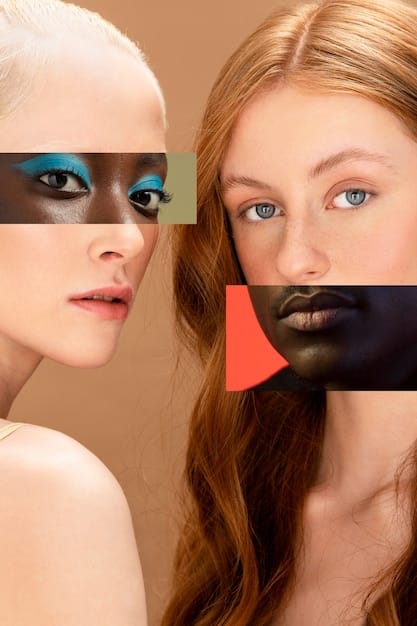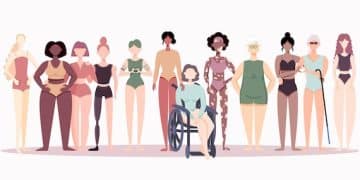The Role of Representation: How Diverse Media Shapes Body Image

Advertisements
The role of representation in media significantly influences body image by shaping perceptions, fostering inclusivity, and challenging societal norms, ultimately promoting more positive and realistic self-views.
Advertisements
The media we consume daily significantly shapes our perceptions of beauty and normalcy. Understanding the role of representation: how diverse media impacts body image is crucial for fostering self-acceptance and challenging unrealistic standards.
Understanding Representation in Media
Advertisements
Representation in media refers to how different groups of people are portrayed across various platforms, including television, movies, magazines, and social media. This portrayal can significantly impact how individuals perceive themselves and others.
The Power of Visual Media
Visual media often sets the standard for beauty and success, influencing viewers’ aspirations and self-esteem. When representation is limited, it reinforces narrow ideals.
Beyond Physical Appearance
Representation extends beyond physical appearance to include cultural backgrounds, abilities, and personal stories, fostering a more comprehensive understanding of diverse experiences.

- Reinforcing Stereotypes: Limited representation can perpetuate harmful stereotypes, affecting how people are perceived and treated.
- Shaping Perceptions: Media images influence how individuals view their own bodies and identities, potentially leading to dissatisfaction and insecurity.
- Creating Role Models: Diverse representation provides positive role models for individuals who may not see themselves reflected in mainstream media.
- Promoting Empathy: Exposure to different cultures and experiences can foster empathy and understanding, breaking down barriers and promoting inclusivity.
By understanding the power and scope of representation in media, we can begin to critically analyze the messages we receive and advocate for more inclusive and authentic portrayals.
The Impact on Body Image
Body image is the mental representation we have of our own body, and media plays a significant role in shaping this perception. Unrealistic portrayals can lead to negative body image and low self-esteem.
Unrealistic Ideals
Media often promotes unattainable beauty standards, leading individuals to feel inadequate when they compare themselves to filtered and Photoshopped images.
The Cycle of Dissatisfaction
Constant exposure to unrealistic ideals can create a cycle of dissatisfaction, where individuals continuously strive for an unattainable goal, impacting their mental and emotional well-being.
- Social Comparison: Media encourages social comparison, where individuals measure their worth against others seen in magazines, movies, and social media feeds.
- Internalization of Ideals: Repeated exposure to narrow beauty standards can lead to the internalization of these ideals, causing individuals to believe they must conform to be accepted.
- Mental Health Impact: Negative body image is linked to anxiety, depression, and eating disorders, underscoring the importance of promoting positive and realistic portrayals.
- Challenging the Norm: Encouraging media literacy and critical thinking can help individuals challenge these unrealistic standards and develop a healthier body image.
Understanding how media influences body image is crucial for developing resilience and promoting self-acceptance in a world saturated with carefully curated images and messages.
The Importance of Diverse Representation
Diverse representation in media means including a wide range of body types, ethnicities, genders, abilities, and identities. This inclusivity is essential for fostering a positive and accepting society.
Breaking Down Barriers
Diverse representation breaks down barriers by challenging stereotypical portrayals and showcasing the beauty in differences, fostering inclusivity and acceptance.
Validating Experiences
Seeing oneself represented in a positive light can validate personal experiences and identities, promoting self-esteem and a sense of belonging.

- Promoting Self-Acceptance: Seeing diverse bodies in media can promote self-acceptance, helping individuals appreciate their unique qualities and feel more comfortable in their own skin.
- Challenging Norms: Diverse representation normalizes differences and challenges societal norms, paving the way for a more inclusive and equitable world.
- Empowering Marginalized Groups: Representation provides a platform for marginalized groups to share their stories and experiences, amplifying their voices and promoting understanding.
- Fostering Empathy: Exposure to diverse perspectives can foster empathy and compassion, encouraging individuals to appreciate and respect the experiences of others.
By advocating for more diverse representation, we can create a media landscape that reflects the true diversity of society and promotes acceptance, understanding, and respect for all individuals.
Positive Effects of Inclusive Media
Inclusive media has numerous positive effects, impacting not only individual self-perception but also broader societal attitudes and beliefs.
Improved Self-Esteem
Seeing diverse representations can boost self-esteem, as individuals feel validated and accepted for who they are, rather than striving for unattainable ideals.
Reduced Stigma
Inclusive media can reduce stigma associated with certain body types, abilities, or identities, promoting greater acceptance and understanding.
Inclusive media fosters greater self-awareness and social consciousness, promoting a more empathetic and understanding society for all.
Creating Positive Role Models
Inclusive media creates positive role models for individuals who may not have seen themselves reflected in mainstream media, providing inspiration and hope.
- Promoting Mental Wellness: Positive representation can contribute to improved mental wellness, as individuals feel more accepted and less pressure to conform to unrealistic standards.
- Encouraging Healthy Behaviors: Seeing diverse bodies engaged in healthy activities can encourage viewers to adopt similar behaviors, fostering a positive relationship with their bodies.
- Amplifying Marginalized Voices: Inclusive media amplifies the voices of marginalized groups, providing a platform for them to share their stories and perspectives, enriching the media landscape.
- Fostering Empathy and Understanding: Exposure to diverse representations can foster empathy and understanding, helping individuals appreciate and respect the experiences of others.
By championing inclusive media, we contribute to a more equitable society where everyone feels seen, valued, and respected for their unique qualities and identity.
Strategies for Consuming Media Mindfully
Consuming media mindfully involves being aware of the messages you are receiving and critically evaluating their impact on your thoughts and feelings.
Critical Evaluation
Critically evaluate the images and messages you encounter, questioning the authenticity and potential biases present in the media.
Limiting Exposure
Limit your exposure to sources that promote unrealistic or harmful ideals, focusing on content that celebrates diversity and self-acceptance.
- Follow Diverse Accounts: Follow social media accounts that promote body positivity and feature a diverse range of bodies and identities.
- Seek Out Diverse Media: Actively seek out books, movies, and TV shows that feature diverse representation and authentic storytelling.
- Practice Self-Compassion: Be kind to yourself and practice self-compassion, recognizing that media ideals are often unattainable and unrealistic.
- Engage in Media Literacy Education: Educate yourself about media literacy and learn how to critically analyze media messages and identify potential biases.
By adopting these strategies, you can become a more informed and discerning media consumer, protecting your mental and emotional well-being and promoting a healthier relationship with media.
Advocating for Change
Advocating for change is essential for creating a more inclusive media landscape that reflects the diversity of society and promotes positive body image.
Supporting Inclusive Content
Support media outlets and creators who prioritize diverse representation and authentic storytelling, amplifying their voices and promoting their work.
Demanding Better Representation
Demand better representation from media companies and advertisers, advocating for more inclusive portrayals that challenge stereotypes and promote positive body image.
- Use Your Voice: Speak out against harmful stereotypes and unrealistic beauty standards, using your voice to advocate for change.
- Support Inclusive Initiatives: Support initiatives and organizations that promote media literacy and advocate for more diverse representation.
- Be a Role Model: Be a positive role model in your own life, promoting self-acceptance and challenging unrealistic beauty standards in your own community.
- Engage in Dialogue: Engage in constructive dialogue with media creators and advertisers, sharing your concerns and suggestions for improvement.
By actively engaging in advocacy efforts, we can create a more inclusive and equitable media landscape that empowers individuals and communities to embrace their unique identities and feel valued for who they are.
| Key Point | Brief Description |
|---|---|
| 📺 Media’s Influence | Shapes body image with often unrealistic standards. |
| ✨ Diverse Representation | Promotes self-acceptance and challenges stereotypes. |
| 💪 Mindful Consumption | Involves critical evaluation and limiting harmful exposure. |
| 📣 Advocacy for Change | Supports inclusivity and demands better representation. |
Frequently Asked Questions
▼
Representation in media is crucial because it shapes perceptions, fosters inclusivity, and provides role models for diverse individuals, validating their experiences and identities.
▼
Media often promotes unrealistic beauty standards, leading to negative body image and low self-esteem as individuals compare themselves to filtered and idealized images.
▼
Mindful media consumption involves being aware of the messages you receive, critically evaluating their impact, and limiting exposure to harmful or unrealistic content.
▼
You can advocate for better representation by supporting inclusive content, demanding better portrayals from media companies, using your voice to speak out, and engaging in constructive dialogue.
▼
Inclusive media can improve self-esteem, reduce stigma, create positive role models, promote mental wellness, and foster empathy and understanding among diverse individuals.
Conclusion
Understanding the role of representation: how diverse media impacts body image is crucial for fostering self-acceptance and advocating for a more inclusive and equitable society. By consuming media mindfully and supporting diverse representation, we can promote positive body image and create a healthier media landscape for all.





